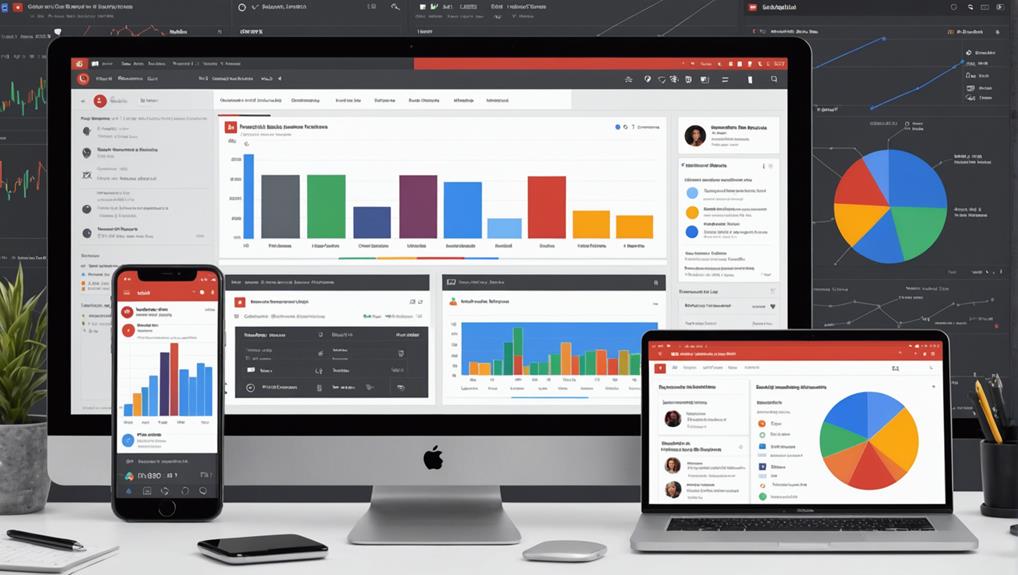Beginners should learn YouTube Analytics to gain essential insights into audience engagement, enabling data-driven decisions to optimize content strategy. It reveals key metrics like watch time, average percentage viewed, and audience retention, which are critical for evaluating content performance. Understanding demographic data helps tailor content to specific viewer segments, enhancing engagement and ensuring content resonates with its audience. Traffic source analysis further aids in refining promotion strategies. Additionally, mastering analytics supports maximizing revenue by identifying high-performing content and aligning strategies with emerging trends. Revealing these insights can greatly boost channel growth and viewer loyalty. Exploring further can reveal deeper strategic advantages.
Key Takeaways
- YouTube Analytics provides insights into audience behavior, helping beginners make data-driven content decisions.
- Analyzing engagement metrics guides content refinement to boost viewer retention and satisfaction.
- Understanding traffic sources helps optimize promotional efforts for better video discovery.
- Demographic data insights allow creators to tailor content for specific audience segments.
- Tracking performance metrics assists beginners in aligning content with successful trends for growth.
Understanding YouTube Analytics
YouTube Analytics serves as an indispensable tool for content creators aiming to enhance their channel’s performance by providing detailed insights into various key metrics.
The channel analytics dashboard offers a thorough view of video performance, focusing on critical elements such as watch time and viewer engagement. By examining audience demographics, creators can strategically tailor their content strategy to align with the specific preferences of their target audience.
Understanding traffic sources is essential, as it helps identify where viewers are discovering content, whether through search, suggested videos, or external platforms.
A fundamental metric within YouTube Analytics is the average view duration, which reflects how well content retains audience attention. A higher average view duration indicates strong viewer engagement and can contribute to subscriber growth.
Additionally, the platform’s four main tabs—Overview, Content, Audience, and Research—facilitate a structured approach to analyzing data. These insights enable creators to refine thumbnails and titles, thereby improving click-through rates and attracting more viewers.
Regularly reviewing these metrics allows creators to pinpoint high-performing content and identify areas for improvement.
Importance of Measuring Analytics
Harnessing the power of analytics is akin to possessing a compass in the vast landscape of digital content creation. By evaluating analytics, creators gain critical insights into audience behavior and engagement, allowing for a strategic approach to content development.
Key metrics like watch time and average view duration reveal which videos captivate audiences, guiding data-driven decisions to refine and enhance content strategy. This process not only improves video quality but also boosts viewer retention.
Understanding audience demographics through analytics serves as a valuable tool for targeting specific viewer segments. This knowledge enables creators to craft content that aligns with the interests and preferences of their unique viewers, fostering a sense of loyalty and increasing engagement.
Additionally, analyzing traffic sources uncovers how audiences discover content, providing opportunities to optimize promotional efforts and expand reach across multiple platforms.
Engagement metrics, including likes, comments, and shares, serve as direct feedback on content resonance. These insights allow creators to refine their offerings, ensuring alignment with audience expectations and enhancing overall channel performance.
Ultimately, the consistent measurement of analytics equips creators with the knowledge needed to make informed, data-driven decisions, essential for thriving in the competitive digital domain.
Analyzing High-Performing Content
Evaluating YouTube analytics not only offers a roadmap for understanding audience interactions but also sets the foundation for appraising high-performing content. By analyzing metrics such as watch time and engagement rate, creators can identify videos that resonate well with their audience, providing insights into successful content strategies.
Watch time reflects the overall interest and relevance of a video, while engagement rate signifies how actively viewers interact with the content. High-performing content often attracts a significant number of unique viewers, indicating its effectiveness in reaching and retaining a broader audience.
Key elements to take into account when analyzing high-performing content include:
- Themes and Formats: Identifying recurring themes or formats that consistently perform well can guide future content creation.
- Presentation Style: Recognizing which presentation styles enhance audience engagement helps tailor content to viewer preferences.
- Comparative Analysis: Side-by-side video performance comparisons highlight successful strategies and areas for improvement, supporting data-driven content optimization.
- Audience Feedback: Analyzing comments and likes provides direct insights into audience engagement and satisfaction.
- Experimentation Opportunities: Continuous review of high-performing videos encourages experimentation with new approaches, leading to refined content strategies and channel growth.
Engaging Target Audiences
Engaging target audiences effectively requires a thorough understanding of demographic data insights, which allows creators to align their content with audience preferences based on age and gender.
By analyzing viewer engagement metrics such as likes, comments, and shares, content creators can gauge resonance and adjust their strategies to enhance viewer loyalty.
Additionally, employing content relevance strategies informed by these metrics guarantees that videos are not only optimized for retention but also strategically aligned with the most impactful discovery platforms.
Demographic Data Insights
Demographic data in YouTube Analytics serves as an imperative tool for content creators aiming to engage specific target audiences effectively. By examining audience demographics, creators can tailor content that resonates with distinct viewer segments, enhancing engagement.
Understanding age ranges is essential, as it informs content themes and presentation styles that appeal to either younger or older audiences. Moreover, gender distribution insights can reveal potential content gaps, allowing creators to adjust their strategies for a more balanced audience appeal.
Geographical distribution data plays a significant role in identifying cultural nuances and language preferences among viewers. This information enables creators to cultivate relevance and forge deeper connections with diverse audiences.
In addition, analyzing demographic data helps in optimizing video release schedules, focusing on peak viewing times by segment to maximize reach and engagement.
Key insights from demographic data include:
- Age ranges: Adapt content themes to match viewer age groups.
- Gender distribution: Identify and fill gaps in content appeal.
- Geographical distribution: Address cultural nuances and language preferences.
- Tailored content: Craft specific themes for distinct viewer segments.
- Engagement optimization: Schedule content releases based on audience demographics.
Harnessing these insights allows creators to refine strategies and achieve more effective audience engagement.
Viewer Engagement Metrics
Understanding viewer engagement metrics is crucial for content creators aiming to deepen their connection with target audiences. YouTube Analytics offers essential insights into how well content resonates through metrics such as likes, comments, and shares, which greatly influence the platform’s video recommendation algorithm. By analyzing the average percentage viewed, creators can determine which videos captivate attention and which require enhancements to boost viewer engagement.
Audience retention graphs are particularly valuable, as they allow creators to identify specific moments where viewers may lose interest. This data-driven approach enables adjustments in content pacing or structure, aligning with viewer preferences. Tracking engagement metrics over time highlights trends, allowing creators to tailor future content strategically to meet audience demands.
Moreover, high engagement rates not only enhance visibility but also foster a loyal subscriber base by prioritizing content that encourages interaction. The following table provides an overview of key metrics and their implications:
| Metric | Implication |
|---|---|
| Likes, Comments, Shares | Indicates content resonance and impacts recommendations |
| Average Percentage Viewed | Reveals content retention effectiveness |
| Audience Retention | Identifies drop-off points for content improvement |
| Tracking Engagement | Highlights trends in viewer preferences |
| High Engagement Rates | Boosts visibility and subscriber loyalty |
Incorporating these insights into a content strategy allows creators to better engage their audiences.
Content Relevance Strategies
Building on the insights gained from viewer engagement metrics, content relevance strategies focus on aligning video content with audience expectations to enhance engagement further.
By leveraging YouTube analytics, creators can explore audience demographics, understanding factors such as age and gender to tailor their content strategies effectively. This targeted approach not only boosts viewer engagement but also enhances audience retention, ensuring a sustained interest in the channel’s offerings.
Analyzing traffic sources is essential for identifying where unique viewers discover content, allowing creators to hone their promotional efforts on the most effective platforms. This analysis directly impacts video performance, guiding creators in optimizing their content dissemination strategies.
Monitoring audience retention provides a window into viewer engagement patterns, highlighting which segments retain interest and where drop-offs occur. This data-driven insight enables modifications in video length and style, fostering greater content relevance.
Engagement metrics, including likes, comments, and shares, serve as a direct barometer of content resonance. They inform creators on successful themes or formats, allowing adjustments that align with audience expectations.
- Understand audience demographics to tailor content.
- Analyze traffic sources to optimize promotional efforts.
- Monitor audience retention for engagement insights.
- Leverage engagement metrics for content feedback.
- Refine content strategies to enhance video performance.
Maximizing Revenue Strategies
To effectively maximize revenue on YouTube, creators must leverage a data-driven approach that focuses on key metrics, such as Estimated Revenue and Playback-based CPM, which indicate the financial performance of individual videos.
By utilizing YouTube Analytics, creators can explore revenue-related metrics to discern which videos yield the highest income, enabling content customization to align with successful trends. Analyzing engagement metrics, including likes, comments, and shares, provides insight into which content resonates with audiences, further informing the optimization of video performance and maximizing profitability.
In addition to monitoring content-specific metrics, establishing and tracking subscriber growth goals is essential for enhancing monetization strategies.
Tools for Data Interpretation
How can creators transform raw data into actionable insights that drive their YouTube success? With YouTube analytics, creators have access to a complete analytics dashboard on YouTube that integrates essential metrics to help steer data-driven decisions.
This dashboard provides valuable insights into video performance, enabling users to assess watch time and audience retention, vital for understanding viewer engagement.
Real-time reporting is another powerful tool in YouTube Analytics. It allows creators to monitor the immediate impact of newly uploaded videos, providing a snapshot of initial audience interaction and helping identify areas for improvement.
Additionally, comparison tools offer a strategic edge by benchmarking current video performance against past content or even competitor channels, highlighting successful tactics.
Furthermore, the ability to generate custom reports tailors data analysis to specific metrics or timeframes, aligning insights with unique content strategies. This feature empowers creators to focus on particular aspects of their channel’s growth and performance.
Consider the following tools for effective data interpretation:
- Complete analytics dashboard
- Real-time performance tracking
- Comparison and benchmarking tools
- Customized reporting options
- External data export for advanced analysis
Utilizing these tools, creators can transform YouTube analytics into a catalyst for success.
Frequently Asked Questions
Why Is Youtube Analytics Important?
YouTube Analytics is essential for understanding YouTube insights, including audience demographics and engagement metrics. It aids in identifying performance trends, optimizing content for viewer retention, analyzing traffic sources, conducting competitor analysis, and facilitating strategic planning for channel growth.
How Do I Use Youtube Analytics to My Advantage?
To leverage YouTube analytics effectively, employ data interpretation to assess viewer demographics, engagement metrics, and content performance. Focus on audience retention, traffic sources, video optimization, competitor analysis, trend tracking, and goal setting for strategic content enhancement.
How Can Youtube Analytics Help You Turn Casual Viewers Into Subscribers and Potentially Loyal Fans?
YouTube Analytics facilitates turning casual viewers into subscribers by offering audience insights, demographic analysis, and performance tracking. By optimizing content strategy based on retention rates, viewer engagement, and competitive analysis, creators can access growth opportunities and drive subscriber growth.
Why Are Youtube Views Important?
YouTube views are pivotal as they enhance video performance by driving viewer engagement and offering valuable audience insights. Analyzing these metrics informs content strategy, optimization, and competitive analysis, ultimately boosting subscriber behavior, growth trends, and monetization potential.
Conclusion
The examination of YouTube Analytics is essential for beginners aiming to optimize their channel’s performance. By measuring analytics, creators can identify high-performing content, effectively engage target audiences, and develop strategies to maximize revenue. Utilizing analytical tools enables a data-driven approach to content creation and audience interaction, fostering informed decision-making. Mastery of these analytical skills is vital for sustaining growth and ensuring long-term success in the competitive digital landscape of YouTube.




